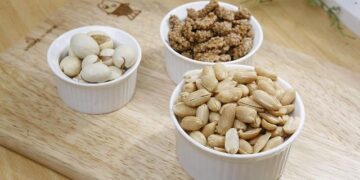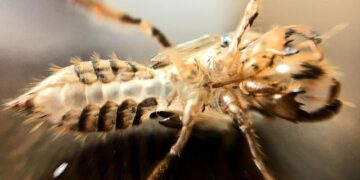In a candid revelation that has sparked curiosity among fans and food enthusiasts alike, Kendra Pierre-Louis, the interim host of the acclaimed podcast Science Quickly, has openly expressed her aversion to mayonnaise. While the condiment’s creamy texture and ubiquitous presence might make it a staple in many households, Pierre-Louis’s distaste goes beyond mere personal preference. In exploring her dislike for mayo, we uncover intriguing insights into the complex world of food psychology-highlighting how sensory perception, cultural influences, and emotional associations shape our eating habits. This article delves into Pierre-Louis’s surprising confession and what it reveals about the intricate relationship between the human brain and the foods we love-or loathe.
Kendra Pierre-Louis Shares Personal Aversion to Mayo and Its Surprising Roots
Kendra Pierre-Louis’s strong dislike for mayonnaise goes beyond simple taste preference; it taps into the complex interplay of texture, aroma, and early food memories that shape our eating habits. Despite mayonnaise’s widespread use as a condiment, she finds its thick, creamy consistency off-putting-a reaction rooted in a psychological phenomenon known as oral tactile sensitivity. This sensory aversion is common but often overlooked, explaining why some individuals have a visceral response to foods that others enjoy effortlessly.
Her experience highlights how food psychology delves deeper than flavors alone. Researchers classify food aversions along various dimensions, including texture, smell, and even cultural context. Below is a simplified overview of common triggers linked to condiment aversions:
| Trigger | Explanation | Common Foods |
|---|---|---|
| Texture | Perceived unpleasant mouthfeel or sliminess | Mayonnaise, okra, natto |
| Aroma | Strong or off-putting smell sensations | Blue cheese, sauerkraut, fish sauce |
| Color | Visual cues triggering rejection | Green-colored dairy, white sauces |
The Science Behind Food Disgust and How It Shapes Our Eating Habits
Human reactions to certain foods often transcend mere preferences, venturing into the realm of evolutionary biology. The aversion that Kendra Pierre-Louis expresses toward mayo is not simply about taste or texture; it taps into deep-seated cognitive mechanisms designed to protect us from potential harm. Disgust is a fundamental emotion that evolved to help humans avoid spoiled or toxic substances. This response is triggered by sensory cues-smell, appearance, or even the memory of a past negative experience. Such reactions illustrate how food disgust operates as an essential survival tool rather than a trivial quirk.
Research underscores that food disgust doesn’t just shape what we avoid-it actively guides our dietary habits, nutritional intake, and social eating behaviors. Below is a simplified breakdown of the main factors contributing to food disgust and their impact:
- Sensory Triggers: Off-putting smell, texture, or taste can elicit immediate disgust responses.
- Cultural Conditioning: Social norms define which foods are acceptable, often reinforcing disgust toward unfamiliar items.
- Evolutionary Bias: Innate mechanisms geared towards detecting contamination and spoilage.
- Psychological Associations: Prior negative experiences can amplify disgust reactions over time.
| Aspect | Effect on Eating Habits |
|---|---|
| Disgust Sensitivity | Heightened avoidance of certain food textures or flavors |
| Culture | Defines acceptable eating practices and limits food exploration |
| Memory | Long-lasting aversions formed by past illness or bad experiences |
| Social Influence | Peer and family attitudes reinforce specific dislikes |
What Mayo Aversion Teaches Us About Overcoming Picky Eating and Expanding Palates
At first glance, a simple dislike for mayonnaise might seem trivial, but it actually opens a window into the complexities of food psychology and how aversions shape our eating habits. Kendra Pierre-Louis’ strong aversion highlights how sensory experiences-texture, smell, and taste-play a pivotal role in the foods we reject early in life. These aversions are often reinforced by emotional associations or repeated negative exposure, setting a precedent that can be tough to overcome. Scientists emphasize that picky eating isn’t just a matter of preference but often a deeply ingrained coping mechanism designed to protect us from unfamiliar or potentially harmful foods.
Overcoming these barriers requires a strategic approach that taps into curiosity and gradual exposure rather than force or shame. Experts recommend methods like:
- Incremental introduction: Slowly incorporating disliked ingredients in small, less intense doses.
- Positive reinforcement: Associating new flavors with pleasant experiences or favorite foods.
- Mindful eating practices: Encouraging awareness and openness during meals to reframe sensory perceptions.
| Strategy | Effectiveness | Example |
|---|---|---|
| Incremental Introduction | High | Adding tiny mayo amounts to a beloved sandwich |
| Positive Reinforcement | Moderate | Enjoying a meal with family while trying new condiments |
| Mindful Eating | Moderate to High | Focusing on textures and flavors during tasting sessions |
The Conclusion
Kendra Pierre-Louis’s strong aversion to mayonnaise may seem like a minor personal quirk, but it opens a window into the complex world of food psychology. Her candid reflections on taste preferences underscore how deeply individual experiences, cultural backgrounds, and even neurological factors shape what we find palatable-or repulsive. As Science Quickly continues to explore the science behind everyday phenomena, Pierre-Louis’s story reminds us that our food choices are more than just flavor-they are a rich tapestry of biology, memory, and identity.































